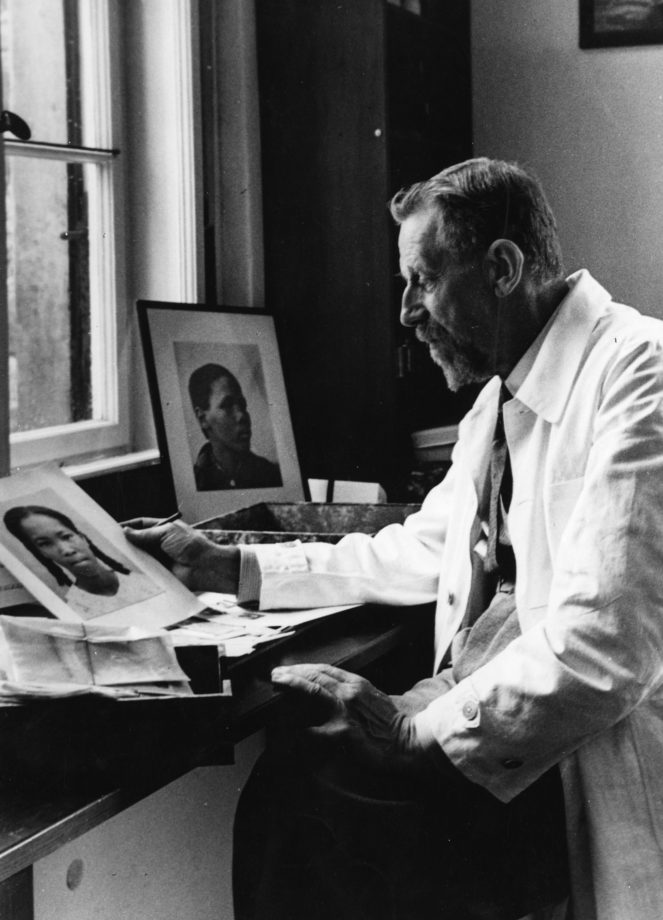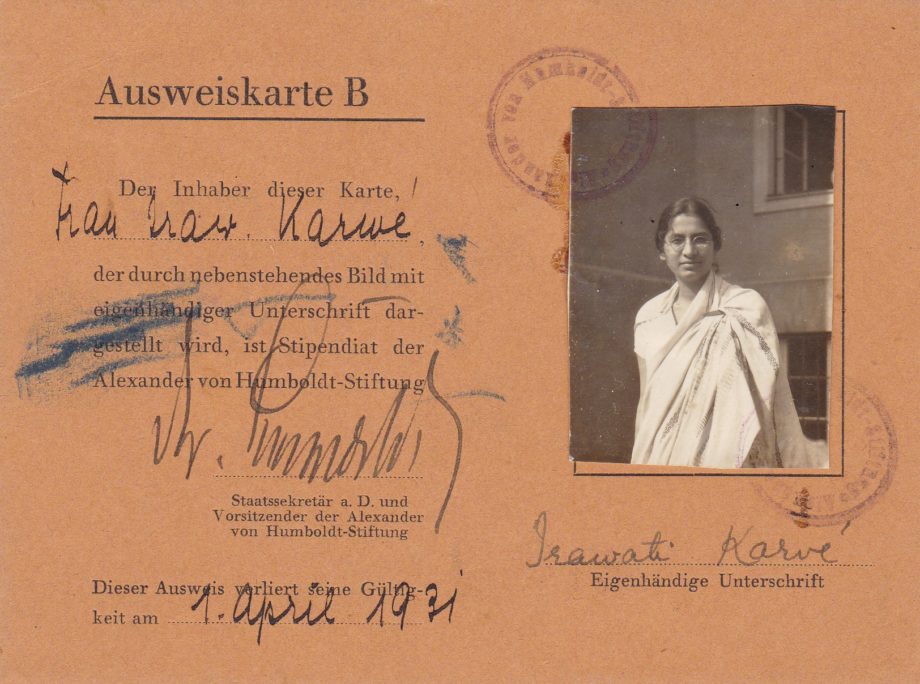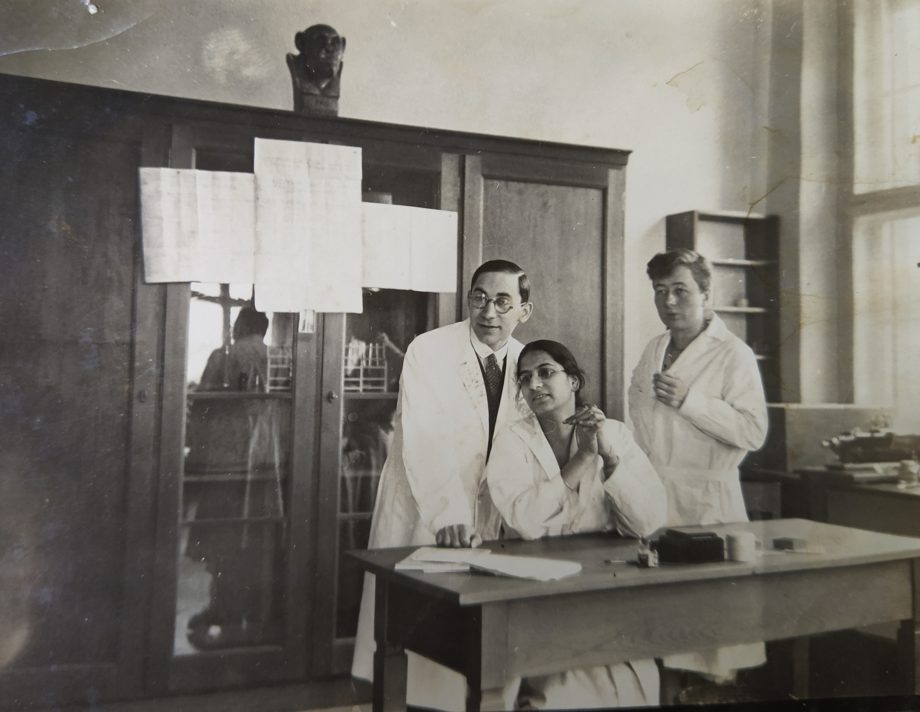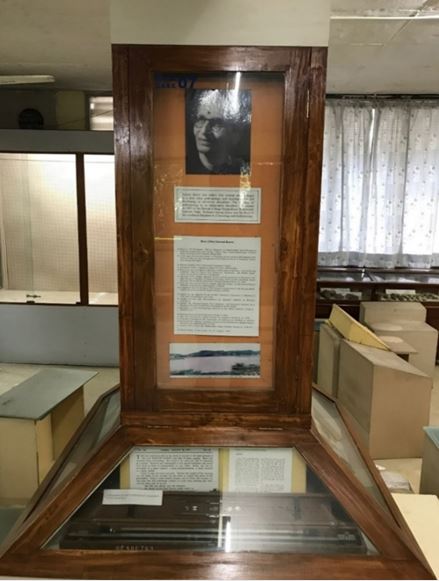Racial anthropology from Germany to India
a transnational look at the scientific racialization of human diversity
“Race” has travelled the world along with many anthropologists. Racial knowledge—as the set of thinking that apprehends human diversity through essentializing relatively fixed categorizations of people, and with a lot of explanatory weight on biology and heredity—has circulated to all corners of the world, on different routes, and through different connections. Especially in the 19th and 20th century tradition of German Anthropologie, a school of anthropology that focused on physical and biological approaches, scientists resorted to racial frameworks to explain and categorize human variation. Working with racial theories and typologies, these anthropologists measured and classified human bodies and remains of human bodies. As much as racial frameworks always sparked debate in science, for many racial anthropologists in Germany and elsewhere at that time “race” held the power to explain all things that they considered to be inheritable—from body shapes and colors to patterns of behavior, culture, and mental abilities.
One of the centers of research in racial anthropology was the Kaiser Wilhelm Institute for Anthropology, Human Heredity, and Eugenics (KWI-A), opened in Berlin in 1927 and closed at the end of World War II. The KWI-A was founded by Eugen Fischer, a German scientist who had travelled to Namibia to make a career out of applying Mendelian genetics to the research of “racial mixing” (what he also called “bastardization”), a topic that triggered a big debate in the German parliament in response to the anxiously reported “Mischehen” (“mixed marriages“) in the country’s settler colonies (El-Tayed 2001; see also Teicher 2020). The KWI-A was a central node in the production of knowledge whose practical application would culminate in the genocidal policies of Nazi Germany. On many different levels, KWI-A scientists were entangled with Nazi eugenicist policies, often in direct support of political measures with the goal of Rassenhygiene or racial cleansing (see Barbosa et al. 2018).

Eugen Fischer examining portraits taken by a doctoral student advised by him, Rita Hauschild (1912–1950), in her fieldwork in Trinidad in the late 1930s. Hauschild researched on the topic Fischer built his young career upon: “racial mixture”. Source: Archive of the Max Planck Society, Berlin-Dahlem.
The consequences of German racial knowledge in Europe are well-known, but the KWI-A was part of a scientific network with a global reach: it contained thousands of human remains from many different colonized territories, and its employees and their publications travelled the world. But the international aspect that surprised me the most when I started my research about the KWI-A was how international its scientific team was: many of the students and researchers at the KWI-A came from abroad, including China, Japan, Turkey, Venezuela, Brazil, and India. So, what happened to racial theories and methods once scientists trained in this eugenicist school of anthropology in Berlin took them further to other parts of the world? This is a question that I and a few other scholars have asked in the last years (see Barbosa et al. 2018, Huang 2022, Birkalan-Gedik 2023). In my doctoral research, I have examined the knowledge-link between German racial anthropology and Indian anthropology. Two Indian anthropologists trained at the KWI-A would have a very influential role in the institutionalization of anthropology in their home country.
“Race” and human diversity in India
The diversity of human bodies and social groups in India has long been a topic of scholarly inquiry, gaining special scientific prominence during the colonial era. “Race” was employed to explain the so-called tribes and castes of the subcontinent, first by European researchers and then also by Indian scientists. These scholars attempted to explain the biological variation of social groups in India through racial theories and methods, thereby racializing the idea of caste and ethnicity. A vast scholarship on the problem of the racialization of categories of difference in India has analyzed the impact of British scientists and colonial-administrative measures (see, for an emblematic example, Dirks 2001). Much has been written about the impact of the anthropologist, colonial administrator, and census commissioner Herbert Hope Risley, who—probably also inspired by his German wife Elsie J. Oppermann’s translations of Anthropologie texts (Bates 1995:241)—developed an anthropometric methodology to measure the extent of an Aryan racial background in the different castes and ethnic groups of India (Risley 1891; see also Figueira 2002; Sur 2011). Risley had been in contact with the ideas popularized by another German, the famous orientalist Max Müller, who had written about how an ancestral Aryan race migrated to South Asia and impacted local languages and society (Figueira 2002).
However, I argue that understanding racial anthropology in India asks us to look beyond a monodirectional genealogy with a single origin point in British colonialism. Other histories of colonial encounters and colonial subjugations, beyond the British empire, co-produced the formation of scientific approaches to human diversity, shaping the racial knowledge that eventually circulated through international scientific networks. In particular, the role of German colonialism and racial scientific knowledge formations in Germany has not been sufficiently studied with regard to this global circulation of “race”. Looking at the figure of Risley alone, we can already perceive—through his connection to Müller and his erudite wife Oppermann—that ideas circulating by and through German intellectuals were foundational to his own racializing elaborations on caste.
Moreover, Risley’s work wasn’t simply taken up by Indian scientists either. In this sense, Risley’s legacy can only partially explain why subsequent generations of Indian anthropologists continued to employ and elaborate on racial theories and methods to explain caste and ethnicity in India. In fact, theories and methods of „race“ circulated transnationally and remained central to the first generations of national anthropologists occupying university positions in India. Historiography of Indian sciences has only recently made more consistent efforts to understand how the legacy of racial sciences was taken up and incremented by national scientists in post-independence India (see Mukherji 2023), many of whom were trained in Europe, and not only in Britain, but also in Germany. If my historical starting point with the KWI-A already pointed at the importance of this school in the formation of key figures in Indian anthropology, in my ethnographic research in sites of anthropological training in India I encountered many other clues to a connection to a racial legacy of knowledge that circulated through or from Germany.
Indians trained at the German school of racial anthropology
Two scholars who had a crucial role in the institutionalization of anthropology in India were trained at the KWI-A in Berlin: Irawati Karve (1905–1970) and Profulla Chandra Biswas (1903–1984). Both were among India’s most influential anthropologists in the decades following India’s independence. Both might have had different reasons to choose Germany as an educational destination. Many Indian students, especially those in anti-colonial intellectual circles (like Karve), chose to go to Germany (over Britain) because Germany was seen as politically more attractive. As part of its foreign policy, the German government deliberately fostered foreign students from territories colonized by its enemies France and UK also through scholarships, like the Humboldt scholarship that both Karve and Biswas had, and by supporting associations of these students, like the Hindustan Haus in Berlin, where many South Asian students and activists gathered (see Jenkins, Liebau, and Schmid 2020; Khan 2020).

Karve’s Alexander von Humboldt fellowship identification card. Source: family archive (courtesy of Urmilla Deshpande).
Karve was India’s first woman to be appointed as a sociology and anthropology lecturer in an Indian university, in the Deccan College in Pune, where she became a professor and worked until 1970, training several students with her holistic approach that combined social, physical, and biological anthropology, including racial anthropometric methods. Biswas was the founder of the Delhi University’s anthropology department and a father figure to the subsequent generations of anthropologists instructed in this heavily physical and biological anthropology-centered school.
Karve’s training in Berlin would cement the legacy of racial anthropology in her scientific career. Exceptionally for a woman at that time and place, she travelled to Germany in 1927 to undertake her PhD in anthropology at the Wilhelm University in Berlin (today Humboldt University), which was in cooperation with the KWI-A, where university students absorbed classes and traineeships in anthropometry—the method of measuring human bodies and human remains. Karve’s doctoral thesis was supervised by Eugen Fischer. Fischer gave her the task to compare the skull asymmetry of human crania of different racial groups. Skull asymmetry (whereby the right side of the skull—the one allegedly responsible for culture and rationality—was larger) was considered an indicator of the civilizational evolutionary achievement of white Europeans. To Fischer’s surprise, Karve raised the question if skull asymmetry wasn’t simply an effect of environmental conditions and, after undertaking craniometric measurements in human remains collections in Berlin, she concluded: there is no correlation between skull asymmetry and race (Karve 1931). While this unexpected conclusion indicates a step away from racist theories that were prevalent at the KWI-A, Karve’s anti-racial argument reflects on-going debates on “race” outside that eugenics-oriented research center as well as Karve’s critical position as a racialized subject herself. But in any case, Karve’s training in the German tradition of racial anthropology left a strong mark in her research.

Photo with Karve (sitting in the middle) taken around 1927-1930 in the KWI-A’s doctoral students’ room. Source: family archive (courtesy of Chanda Nimbkar, Nandini Nimbkar-Rajvanshi, and Urmilla Deshpande).
Once back in India and working from 1939 in Pune, a city known to be an intellectual hub in Western India, Karve applied racial theories and methods to comment, and intervene in, crucial political debates in India. She adapted anthropometric and other biological anthropological methods to study caste and ethnic groups in India, trying to formulate a generalizing image of these groups’ bodies and, based on that, construct inferences about their ancestral history and culture (see Barbosa 2018, 2022). In the context of India’s decolonization and early post-colonial decades, racial theories—with their ability to assert sameness, difference, and belonging—would have profound political resonance. This impact was heightened by the status of public intellectual that Karve, authoring hundreds of publications and participating in several mediatized discussions, would take. For instance, in 1947, the year of India’s and Pakistan’s partition and independence, Karve published a speech that was strongly anti-Muslim and racist. Held in a highly influential political and scientific conference in Delhi (the Asian Relations Conference hosted by Prime Minister Jawaharlal Nehru), the speech racialized Muslims, based on their allegedly distinct cultural and behaviorist characteristics, and labelling Islam to be racially incompatible with the Hindu nation. Afterwards, in the decade following India’s independence, Karve continued to work with anthropometry. She applied a physical and biological anthropological framework to study Indian caste and ethnic groups, at the same time that she linked such anthropometric and other biological data with remarks about these groups’ culture, behavior, and history, thus racializing them. Most of her research focused on the region that would become the state of Maharashtra and its surroundings. In fact, as I have described elsewhere in detail, Karve’s anthropometry-based writings would create a picture of a racially (biologically and culturally) cohesive Maharashtrianness, thus contributing to an on-going political debate (and struggle) for the creation of the regional state of Maharashtra, which finally happened in 1960.
While Karve published widely and gained some international acknowledgement for her social anthropology of the caste system as well as national acclaim for her pioneering work on culture and gender, Karve did devote a lot of her research efforts to physical and biological anthropology throughout her career, using the anthropometric instruments she brought with her from Berlin and referring to racial theories. Even so, there were important changes in her scientific discourse in the 1950s and 1960s. Also politically, her public intellectual engagement was, by the 1960s, very different from—if not contrary to—her anti-Muslim views ruthlessly proffered two decades earlier. Concomitantly, she gravitated towards multiculturalism, embracing the new national, post-Partition slogan of “unity in diversity”, and publicly defended that all different social and religious groups in India should live in harmonious comradeship. At the same time, she also had to engage with a criticism towards racial anthropology. While she still used racial anthropometric methods of classification to characterize castes and ethnic groups in the late 1960s, she then wrote disclaimers to try to prevent that people would feel “discriminated against” by such methods.
In short, Karve came to acknowledge, at least to some extent, the risk of racial anthropology’s harmful political impact, and even reviewed racial theories, but she continued to resort to a racial methodology. If only clearly visible from our present historical standpoint, such contradictions would be glimpsed by her at the end of her life, provoking deep philosophical ruminations. They were also a reason for some international criticism against her physical and biological anthropological work by late 1960s, when a critical revision of the methods and assumptions connected to German racial sciences was on the rise.
Biswas, in turn, as the first head of the Delhi University’s anthropology department, shaped that North Indian school of anthropology very closely in line with the anthropometry-based tradition he was trained in in Berlin (Bandeh-Ahmadi 2018). Biswas was a big influence in the following generation of Delhi anthropologists, many of whom also got Humboldt scholarship and went to Germany to be skilled in that tradition of Anthropologie.
The German history of objects in Indian anthropology
Many traces of the anthropological entanglement between Germany and India can be perceived in objects that are present today in sites of anthropology teaching and research in India. In classes of biological anthropology in India, a few widely used textbooks brought this connection to the fore. One of these books was Anthropometry: A Laboratory Manual on Biological Anthropology, co-authored by Indera Paul Singh, who, following the steps of his mentor Biswas, went to Germany in the 1950s to be trained in Anthropologie. Singh basically summarized and translated a German textbook of anthropometry, the German-Swiss anthropologist Rudolf Martin’s 1914 Lehrbuch der Anthropologie in systematischer Darstellung, which has been known as a standard reference in anthropometric methodology and racial classifications (Morris-Reich 2013). The Indian translation of this book is still widely used in anthropology schools in India today (Singh & Bhasin 1968). The book was reprinted many times after its first publication in 1968, the latest one being in 2008. Another physical anthropology manual that many Indian students work with was also written by another Indian anthropologist trained in Germany, B. M. Das (2008).
Besides these textbooks, the legacy of German physical anthropology was also present in the instruments used in the anthropometry courses. Different anthropology departments in India possess several instruments that were designed by Rudolf Martin, including the cubic craniophor (the instrument used by Karve in her craniometric research in Berlin), the anthropometer or anthropometric rod, and the still much used instruments spreading caliper and sliding caliper. In addition, in anthropology labs in Pune I encountered three objects with clear engraved signs of their German origin: The first a hair color and hair texture chart, with an imprinted mark of the piece’s fabrication in Kiel, Germany, designed and popularized by Eugen Fischer; The second instrument was a two-piece skin color chart with 36 colors designed by Berlin-based anthropologist Felix von Luschan (1854–1924); The third was an eye color chart, with an engraving on the back of its metallic box: “Rudolf Martin’s and Bruno K. Schulz’s eye-color chart, [address], Munich”. Once part of the standard equipment in this racial anthropology that became mainstream in the first half of the twentieth century, these three instruments are not used in the training of students anymore. But the calipers and anthropometric rod are taught to the students, even if rather for the purposes of forensic anthropology and studies of human growth and nutrition.

Irawati Karve cabinet in the Irawati Karve Museum of Anthropology, Pune. The cabinet contains a Martin anthropometer (on the bottom). Photo taken by the author.
In sum, this assemblage of physical anthropology textbooks and anthropometric measurement devices—among working and retired ones—demonstrates links to a transnational network of a tradition of racial anthropology that once had its central nodes in Germany.
A transnational gaze at “race” in anthropology
Tracing a genealogy of racial scientific knowledge cannot be done through a simple, mono-linear model of historicism. In this blog post, I have focused on a few transnational connections that ensued from one central (though not the only) node of racial knowledge production, the KWI-A in Berlin. From the KWI-A, such racializing knowledge has reached far beyond the borders of Europe. The case of the Indian scientists who were trained in this German racial anthropology, most notably Karve and Biswas, makes evident how this tradition of thinking has had an influence over the approaches to study human diversity in India. Both Karve and Biswas adapted, researched, and taught with the instruments, theories, and methods they were trained with in Berlin. Thereby, they injected a new racializing impulse to the scholarly inquiry on human variation in India, crucially renewing the energy of a longer genealogy of racial approaches to caste, religion, and ethnicity in the Indian subcontinent. Therefore, their work reinvigorated the racialization of these categories of difference in India. Tracing this legacy of racial anthropology helps to understand the political and social phenomena that have been animated by racialized, essentialized and rigid, conceptions of religious, ethnic, and caste categorizations.
While most of the scholarship on the racialization of caste and ethnicity in India has focused on the impact of British colonialism, applying transnational lenses to the study of racialization in science can be very insightful. Here, we have seen that several connections to German (and more-than-German) racial anthropology—from Müller to Risley (and his wife) as well as the KWI-A with its alumni Karve and Biswas—show that the genealogy of racializing sciences does not only follow colonizer-colonized lines. Understanding these messy and serendipitous—but important—transnational connections helps to better understand both the historical resilience and the global capillarity of racial and racist knowledge.
References
Bandeh-Ahmadi, Nurolhoda. 2018. “Anthropological Generations: A Post-Independence Ethnography of Academic Anthropology and Sociology in India.” Doctoral dissertation, University of Michigan. Accessed July 12, 2022. https://deepblue.lib.umich.edu/handle/2027.42/145949.
Barbosa, Thiago P. 2018. “Making Human Differences in Berlin and Maharashtra: Considerations on the Production of Physical Anthropological Knowledge by Irawati Karve.” Südasien-Chronik – South Asia Chronicle 8: 139–62. https://www.iaaw.hu-berlin.de/de/region/suedasien/publikationen/sachronik/06-forum-barbosa-thiago-pinto-making-human.pdf.
Barbosa, Thiago P . 2022. “Racializing a New Nation: German Coloniality and Anthropology in Maharashtra, India.” Perspectives on Science 30 (1): 137–66. https://doi.org/10.1162/posc_a_00405.
Barbosa, Thiago P., Owen Brown, Julia Kirchner, and Julia Scheurer. 2018. “Remembering the Anthropological Making of Race in Today’s University: An Analysis of a Student’s Memorial Project in Berlin.” Etnofoor 30 (2): 29–48.
Barbosa, Thiago P., Owen Brown, Luca Mundle, Julia Kirchner, and Julia Scheurer. 2016. “Manufacturing Race: Contemporary Memories of a Building’s Colonial Past.” Accessed February 02, 2019. http://manufacturingrace.org/.
Bates, Crispin. 1995. “Race, Caste, and Tribe in Central India: The Early Origins of Indian Anthropometry.” In The Concept of Race in South Asia, edited by Peter Robb, 218–57. Delhi: Oxford Univ. Press.
Birkalan-Gedik, Hande. 2023 (forthcoming). Traveling Theories, Traveling Theorists: Seniha Tunakan, “die kleine Türkin” at the KWI-A at Ihnestraße 22-24 and at Ankara University. Journal of Folklore Research.
El-Tayeb, Fatima. 2001. Schwarze Deutsche: Der Diskurs um „Rasse“ und nationale Identität 1890 – 1933. Frankfurt/Main: Campus Verlag.
Channa, Subhadra. 2003. “Colonialism, Caste and the Myth of Race: A Historical Perspective on the Interaction of Indian Beliefs and Western Science.” In Understanding People of India: Anthropological Insights, edited by A. K. Kalla and D. K. Bhattacharaya, 535–53. New Delhi: University of Delhi.
Clever, Iris, Jaehwan Hyun, and Elise K. Burton. 2022. “People in Motion: Introduction to Transnational Movements and Transwar Connections in the Anthropological and Genetic Study of Human Populations.” Perspectives on Science 30 (1): 1–12. https://doi.org/10.1162/posc_e_00400.
Das, B. M. 2008. Outlines of Physical Anthropology. 26th ed. Allahabad: Kitab Mahal.
Figueira, Dorothy Matilda. 2002. Aryans, Jews, Brahmins: Theorizing Authority Through Myths of Identity. Albany: State University of New York Press.
Huang, Weicheng. 2022. “Rasse Als Transnationales Konstrukt: Die „Mischling“-Studie des Anthropologen Tao Yun-Kuei in Deutsch-Chinesischen Kontexten.” MA thesis, Otto-Suhr-Institut für Politikwissenschaft, Freie Universität Berlin.
Karve, Irawati. 1931. Normale Asymmetrie des Menschlichen Schädels: Inaugural-Dissertation. Leipzig: Schwarzenberg & Schumann.
Khan, Razak. 2020a. “Entangled Institutional and Affective Archives of South Asian Muslim Students in Germany.” https://www.projekt-mida.de/reflexicon/entangled-institutional-and-affective-archives-of-south-asian-muslim-students-in-germany/. Accessed May 30, 2023.
Martin, Rudolf. 1914. Lehrbuch Der Anthropologie in Systematischer Darstellung. Jena: Gustav Fischer.
Morris-Reich, Amos. 2013. “Anthropology, Standardization and Measurement: Rudolf Martin and Anthropometric Photography.” Brit. J. Hist. Sci 46 (03): 487–516.
Singh, Indera P., and M. K. Bhasin. 1989 [1968]. Anthropometry: A Laboratory Manual on Biological Anthropology. Delhi: Kamla-Raj Enterprises.
Sur, Abha. 2011. Dispersed Radiance: Caste, Gender, and Modern Science in India. New Delhi: Navayana.
Sundar, Nandini. 2008. “In the Cause of Anthropology: The Life and Work of Irawati Karve.” In Anthropology in the East: Founders of Indian Sociology and Anthropology, edited by Patricia Uberoi, Nandini Sundar, and Satish Deshpande, 360–416. Calcutta: Seagull.
Thiago Pinto Barbosa holds a PhD in social and cultural anthropology from the University of Bayreuth and teaches at the Vrije Universiteit Amsterdam and the University of Göttingen. Thiago’s research interests include racism, inequalities, and the interplay of politics and scientific knowledge. Together with fiction writer Urmilla Deshpande, Thiago is currently working on a book project on the life of Irawati Karve.































